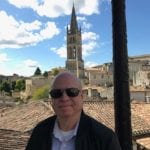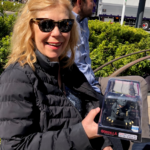SE Asia Trip: Cambodia
Arrival in Cambodia was a bit comical. Cambodia does visas on entry. This is handled by turning in your form, $20 and a picture along with your passport. These are then handed down a long counter of officials while everyone waits. They call you name, and listening to the Cambodian officials trying to pronounce the names is pretty entertaining. After you get your passport back, you then stand in another line to get it stamped. The whole process took close to an hour.
Our guide in Siem Reap was named Da Ling, he immediately became Darling to the group. Like all of the guides who work for Travel Indochina, he was excellent. Our hotel was the Victoria. I really liked the hotel. It fit very well into the atmosphere of Siem Reap. Lots of hard woods, nice balcony, great pool area. The center of the hotel is an open air courtyard. Breakfast was served in an open air area overlooking the pool, and was quite good.
After checking in to the hotel, we drove about an hour out of town to Tong Le Sap Lake. This is a huge lake that runs down the center of Cambodia and at one point (before over fishing) provided enough fish for something like half the population of the country. We took a boat tour around the floating village on the edge of the lake.
On the drive out to the lake and on the boat tour, it became more and more obvious that Cambodia is, well, different. We heard something about income being something around a dollar a day on average. The people living around the lake were supposedly well off and can make $2 a day.
The boat tour around the lake was enjoyable, laid back, but did give us an up close view of how hard life can be here. There are schools and such, mostly sponsored by foreign aid organizations.
After the boat ride, we went to Angkor Wat itself for sunset. There were enough clouds that we did not get a great sunset, and we were only at the Temple for about 30 minutes. We went back two days later. Dinner was at a local restaurant called Viroth’s; one of many recommended by Travel Indochina. It is supposed to be a modern take on Khmer food. Much like Thai but a bit more subtle in flavors. Nothing really spicy, lots of curries, all rather light and refreshing.
A bit about the Angkor Complex: During the 12th and 13th century, the area around Siem Reap was the center of the Khmer Empire. This empire ruled most of mainland South East Asia. They were Hindu with strong cultural ties to India. At its peak, the city of Angkor Thom had well over a million residents. The kings built numerous temples to the various Hindu Gods. Angkor Wat is the largest, it is said to be the largest religious structure ever built, and at nearly a square mile, one can believe it. The Khmer empire was overthrown by the Thais in the late 13th century and the cities and temples were sacked and were mostly forgotten until the 19th century when the French occupied Indochina and rediscovered the temples. With all of the intervening wars and chaos, it remains one of the less visited areas of the world.
The next day we visited four of the smaller temples, ranging from Beung Meleay, which is pretty much unrestored, up to the temple where Angelina Jolie starred in Laura Croft, Tomb Raider. The temples really cannot be described; they have to be seen. Suffice it to say you know you are somewhere different!
The next morning we got up very early to see sunrise at Angkor Wat. This goes down as one of the coolest things I have ever done. After the sunrise, we toured the whole temple complex, which is incredible. Again, not easily described. Suffice it to say that it exceeded my considerable expectations.
After a box breakfast, we went on to Bayon, which is the second most famous temple. We got to ride elephants around the temple, and then climbed around the top of the temple complex. This temple is Buddhist and features something like 142 faces of Buddha, along with some incredible carvings of battles. Great stuff.
Before leaving Siem Reap, we visited the Angkor Hospital for Children. The Cambodian civil war left the country devastated; virtually the entire educated class was slaughtered by the Khmer Rouge. We were told that there were 4000 doctors in Cambodia in 1975 and 4 in 1979. Angkor Hospital for Children is run by a foundation out of New York. Travel Indochina sponsors a nurse; they paid for her training and pay her annual salary. It was Sunday, so much of the hospital was closed, but we saw their video and chatted with some of their staff. We passed the hat and collected enough money to buy 350 kilos of rice, enough for the hospital for a month.
We then left Siem Reap for Phnom Penh by bus. The drive took several hours. The country side is quite interesting. We stopped for lunch at the home of an American Vietnam Vet and his Khmer wife. They run a small project designed to keep at-risk women out of the sex trade (a major problem in Cambodia). They hand spin and weave silk scarves, which they then sell for $15 to $20 a piece. They are very nice. We also stopped at a rest stop that featured a roadside Cambodian delicacy; fried bugs. I passed on the spiders.
On arrival in Phnom Penh we made a stop at another project that employs the disabled; a place called Seeing Hands Massage. We all got massages done by blind people; one hour massage for $6.
As mentioned, Cambodia mostly uses the US Dollar. Change is a problem. I suggest getting a large stack of ones!
We spent two nights at the Raffles Phnom Penh. This was first built in 1929 and has survived the ravages of war. It is an absolutely spectacular hotel. The rooms in the main building are right out of colonial times, with big claw-footed bathtubs, etc.
Monday was very good and very grim. We visited the Royal Palace in the morning, architecture quite reminiscent of Thailand. The king was in residence, but we somehow did not get invited in for tea. We also stopped at the National Museum, which has an excellent collection of statuary, much of it from Angkor Wat. Then it got serious. We went to Tuol Sleng, a former high school used by the Khmer Rouge as a prison/torture center. The Khmer Rouge era was a period of pure terror in which some 2 million people died, most of them horribly. There are signs all around the center advising people to keep quiet and not to laugh. They are not necessary.
We had lunch at a facility that employs homeless kids and trains them for the hospitality business. Good food.
After lunch we went to the killing fields. This is one of hundreds of places around the country where the Khmer Rouge executed their victims. By the thousands. There are bones still eroding out of the ground. The only monument is a stupa filled with skulls. The guide (who lost two family members to the Khmer Rouge) spares no details in his descriptions. This is not a pleasant place. I am glad I saw it; I do not want to go back.
On the way back to town, we stopped at the Russian Market, with much tourist stuff. And finished the day with a very elegant dinner of world class cuisine at the Raffles.




